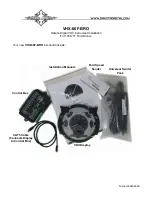
18
AUTOCOM PRO MDX1400
4.1.1 The AUTOCOM PRO In Digital Recording And Sampling
In an analog recording, too low recording levels lead to an increased noise level, whereas too high levels will
cause a compressed and squashed sound. In extreme cases, it will cause distortion due to tape saturation.
In contrast to analog, side effects in the digital field always become extremely audible: with decreasing level,
a tape previously recorded with insufficient level loses resolution: the recording sounds hard and loses
atmosphere. With excessive level, the recording sounds harsh and heavily distorted. In order to avoid these
effects, the AUTOCOM PRO as a limiter should be placed before for example a sampler. As a result of this
process, a digital recording or a sampling event can be optimally set in level without any problem.
4.1.2 The AUTOCOM PRO In Mastering
The mastering process is one of the most critical processing steps in recording. In this production step, it is
the goal to achieve a maximum level copy of the recording, without any noise or distortion. In many
applications it is further required to produce a high average volume. In the field of commercial media for
example, this is apparent especially with records and cassettes which are processed with high average
volumes. Quite often in these cases, dynamics suffer drastically, because the program material has been
compressed and limited too heavily. Using the Compressor section of the AUTOCOM PRO as a limiter allows
you to drastically increase the overall volume, without audibly affecting the dynamics.
Proceed as follows:
Limit the dynamics of the program material by 6 dB using the AUTOCOM PRO as a Peak Limiter (Ratio
1:oo). By softly clipping just the transients, the real audio signal will not be limited, resulting in a higher
headroom. The overall gain can now be increased by 6 dB, which leads to a higher volume. More than 6 dB
should not be limited, otherwise side effects could become audible.
This effect is particularly noticeable with DAT recorders, whose level indicators achieve a response time of less
than 1 ms. Set the DAT recorder at unity and now reduce the LEVEL control of the peak limiter until a gain
reduction of 6 dB is indicated. The cut signal peaks cause a reduced recording level of about 6 dB, which is
visible on the level indicators of the DAT recorder. Now increase the recording level of the recorder back to
unity. The result is a clearly louder recording without any loss of sound.
4.2 The AUTOCOM PRO As A Protective Device
Sound system distortion is usually a result of amplifiers and loudspeakers being driven beyond their limitations
by signals clipping. The signal limitations that occur lead to unpleasant distortion that is dangerous to the
speakers.
A speaker diaphragm is required to accelerate, slow down, smoothly change direction and accelerate again in
normal operation. Distorted operation (clipping) leads to instant acceleration, instant stop, change of direction
and instant acceleration again. Since speaker diaphragms are subject to the laws of physics, they will not take
this kind of punishment for long: the diaphragm will either break up or its voice coil may overheat.
In addition to the damage caused by sustained overload, the speaker may also be damaged by an occasional
high level overload, e.g. the sound of a microphone falling onto a hard floor. Even if this type of transient does
not destroy a speaker outright, it may damage the speaker surround in such a way, as to cause mechanical
abrasion and future failure. It is recommended that you use the Behringer AUTOCOM PRO in order to protect
the speaker. Brick Wall peak limiters are not normally necessary for PA systems, as amplifiers and
loudspeakers are tolerant of short signal peaks.
Nevertheless, conventional limiters have to be generally driven far beyond the headroom limit of an amplifier, in
order to limit the level and length of the transients responsible for overloading the system. The disadvantage of
this principle is that the units full range cannot be completely used. If an increase in the average level of up to
3 dB is attained with the AUTOCOM PRO as a Limiter, this means that you effectively double the power
amplification. The AUTOCOM PRO can act in this way to convert a PA system of 5,000 Watts into a distortion
free 10,000 Watts system. The following instructions will help you to integrate the unit into your system.
4.2.1 Protection Of A System With A Passive Crossover
If your sound system incorporates a passive crossover network (included in the loudspeaker case), insert the
BEHRINGER AUTOCOM PRO between your mixing console output and the power amplifier input. It is used as
the last link in the chain preceding the power amp. Thus, you can effectively avoid the technical knockout of
4. SPECIAL APPLICATIONS
Downloaded from
www.Manualslib.com
manuals search engine











































